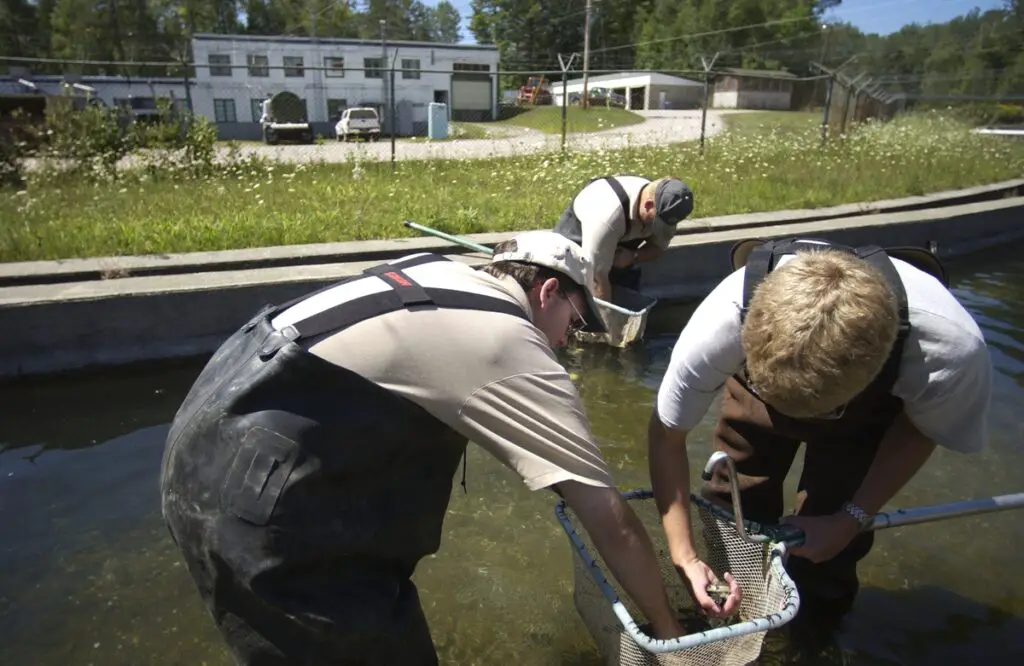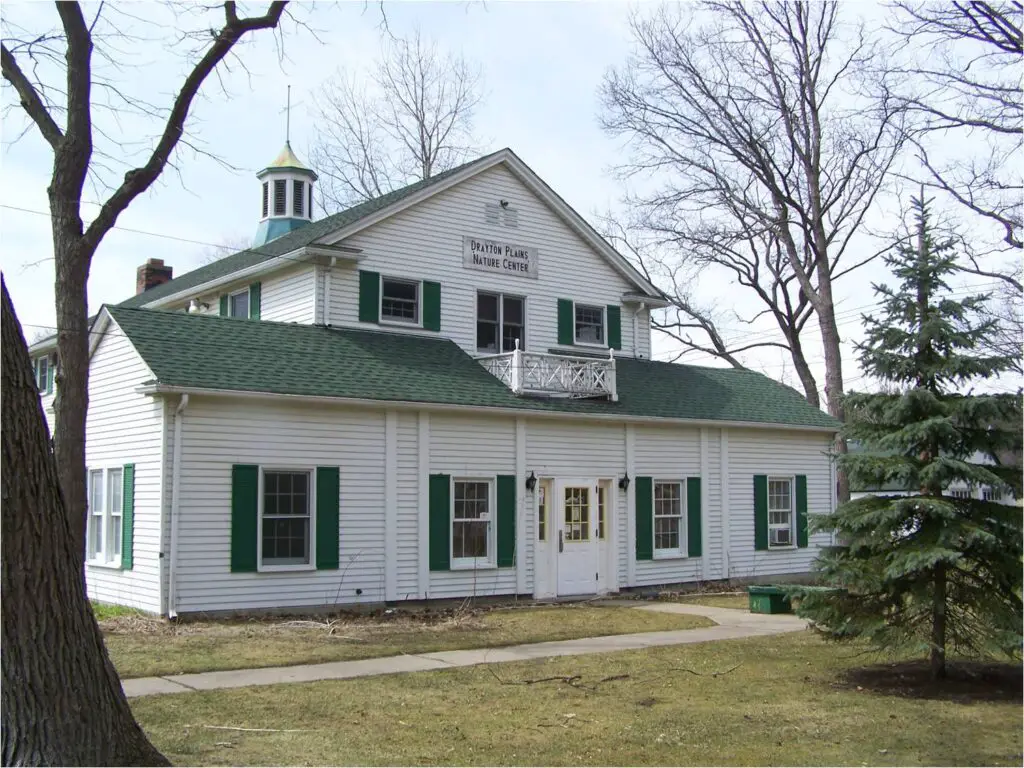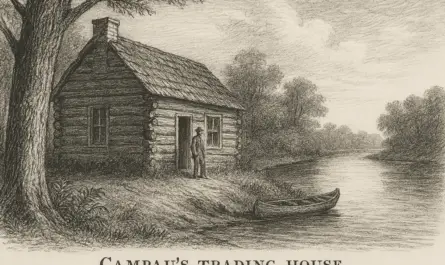Michigan fish hatcheries have played a crucial role in the state’s sportfishing legacy. Their main objective is to ensure the well-being of fish populations, and as a result, they have made significant contributions to the state’s economy and ecosystem. This blog post closely examines Michigan’s fish hatcheries’ history, purpose, and impact.
Table of Contents
The Need for Michigan Fish Hatcheries
In the early 1800s, Michigan’s landscape was covered by old-growth forests, and its waterways teemed with fish. However, rapid economic growth, deforestation, and the arrival of invasive species like sea lamprey took a toll on fish populations. By the 1870s, it was evident that Michigan’s fish populations were in trouble, leading to the establishment of the Michigan Fish Commission and the opening of the first fish hatchery, Crystal Springs, near Pokagon in Cass County in 1873.
Michigan’s Fish Hatcheries: Then and Now
Over the years, Michigan’s fish hatcheries have evolved, incorporating modern technology and adjusting rearing methods to ensure healthier fish populations. Today, the Michigan Department of Natural Resources (DNR) operates six fish hatcheries, five permanent egg-take stations, and up to 40 rearing ponds.
Marquette State Fish Hatchery

Established in 1920, the Marquette State Fish Hatchery in the north-central Upper Peninsula has contributed to Michigan’s aquatic life. Over the years, the hatchery has undergone several renovations, including a partial renovation in 1994 when a roofed structure was added to enclose its raceways. Today, it remains the sole production center for all char species stocked in Michigan, including the beloved brook trout, lake trout, and the hybrid splake. As one of the state’s oldest hatcheries, Marquette State Fish Hatchery is a testament to Michigan’s rich conservation and sustainable fishing history.
Thompson State Fish Hatchery

The Thompson State Fish Hatchery, located in the picturesque Upper Peninsula near Manistique, has a rich history dating back to its establishment in 1922. Initially built to rear Chinook salmon, steelhead, Atlantic salmon, and rainbow trout, the facility was rebuilt and modernized in 1976 to meet the growing demand for fish production in the region.
In 2021, the hatchery underwent another transformation by adding a new cool water production facility, which allows for the rearing of muskellunge and spring-fingerling walleye. This expansion is a testament to the hatchery’s commitment to staying at the forefront of fish production technology and meeting the evolving needs of the fishing industry in the region.
Oden State Fish Hatchery

Oden State Fish Hatchery has been serving its community since 1921, and in 2002, it was rebuilt to serve its purpose better. The modern facility has a state-of-the-art incubation and early-rearing building, enclosed concrete raceways, and a broodstock-rearing building. Oden’s commitment to fostering aquatic life is evident through its breeding and rearing of brown and rainbow trout, which are then used for stocking programs. The hatchery’s dedication to maintaining healthy and thriving fish populations has made it a vital part of the local ecosystem, and anglers and nature enthusiasts alike have appreciated its efforts.
Platte River State Fish Hatchery

The Platte River State Fish Hatchery, which has existed for almost a century, began operations in 1928. It was originally established to meet the growing demand for salmon and initially reared Chinook salmon. The hatchery underwent a major overhaul in 1975 to improve its capacity and has since added Atlantic and coho salmon to its repertoire. In addition to salmon, the facility also incubates and hatches walleye eggs each spring, making it a vital contributor to the region’s fishing industry. In 2004, the hatchery underwent a partial renovation to modernize its equipment and ensure it could continue to produce healthy fish for the foreseeable future.
Harrietta State Fish Hatchery

The Harrietta State Fish Hatchery, situated close to the charming town of Cadillac, has a rich history that spans over a century. Established in the year 1901, it holds the distinction of being the oldest and most enduring hatchery in Michigan. Over the years, it has undergone several transformations, with a major renovation taking place in 1978. Today, it proudly boasts a rearing program that includes diverse fish species, such as brown trout, rainbow trout, and Atlantic salmon. This hatchery is not just a place of production but also a living testament to Michigan’s rich fishing heritage and a must-visit destination for anyone interested in learning more about the state’s piscine past.
Wolf Lake State Fish Hatchery

Did you know that Wolf Lake State Fish Hatchery has a rich history dating back to its establishment in the early 1900s. Built initially to rear trout, the hatchery underwent a total renovation in 1982, which included the construction of a new hatchery building, outdoor raceways, and a standalone visitor center. Today, the hatchery is home to diverse fish species, including muskellunge, walleye, steelhead, and Chinook salmon. This site has played a significant role in conserving and managing Michigan’s fish populations for over a century.
Purpose and Contributions of Fish Hatcheries
Fish hatcheries in Michigan serve several essential functions:
- Reintroduction of species: Hatcheries help to reintroduce extirpated species and rehabilitate depressed fish stocks.
- Ecosystem balance: They aid in achieving a balance between predator and prey species within the ecosystem.
- Diverse fishing opportunities: By stocking a variety of fish species, hatcheries contribute to diverse fishing opportunities for anglers.
- Environmental conservation: Hatcheries work to preserve and improve fish habitats, ensuring sustainable fish populations for future generations.
Drayton Plains Fish Hatchery: A Local Treasure

The Drayton Plains Fish Hatchery, located in Waterford Township, Michigan, was established in 1903. The hatchery played a crucial role in rearing various fish species, including walleye, northern pike, and trout. The Michigan Department of Conservation operated the facility and the Michigan DNR before closing in 1962. The Drayton Plains State Fish Hatchery was listed as a Michigan Historic Site on August 24, 1984.
The Drayton Plains Nature Center is now where a fish hatchery used to be. Since it opened in 1967, visitors have been able to explore the 138-acre area that includes a mile-long stretch of land with various exhibits and educational programs. The center showcases nature in many ways, including woods, ponds, streams, and prairies. Additionally, visitors can check out the interpretive center, which displays specimens in their natural habitats. There are also expansive trails to explore on the grounds.
Saulte Ste. Marie Fish Hatchery

The Sault Ste. Marie Fish Hatchery, located in Sault Ste. Marie, Michigan, was established in 1887 as a Federal Fish Hatchery. It was one of the first fish hatcheries in the United States and played a significant role in the early history of fish propagation and management in the Great Lakes region.
The hatchery initially focused on rearing various trout and salmon species, including lake trout and whitefish, to replenish depleted populations in Lake Superior and other Great Lakes waters. Over time, the hatchery expanded its operations to include other species such as walleye, northern pike, and muskellunge.
In 1956, the Sault Ste. Marie Fish Hatchery was transferred from federal to state control, and the Michigan Department of Natural Resources (DNR) took over its management. However, the facility was eventually closed down in the 1970s due to budget constraints and the consolidation of hatchery operations in Michigan.
Today, the original hatchery building has been repurposed and is now home to the River of History Museum. The museum showcases the history of Sault Ste. Marie and the surrounding region, including the impact of the fish hatchery on the area’s fishing industry and natural resources.
Video: Celebrating 150 years of Michigan fish hatcheries
Final Thoughts on Michigan Fish Hatcheries
Fish hatcheries have a long and storied history in Michigan, supporting the state’s fish populations, ecosystems, and sportfishing industry. Modern hatcheries, such as those operated by the Michigan DNR, continue to innovate and adapt to ensure the health and well-being of Michigan’s aquatic life. The Drayton Plains Fish Hatchery, though no longer in operation, remains an integral part of this heritage and serves as a reminder of the critical role that hatcheries play in preserving and promoting Michigan’s valuable natural resources.



